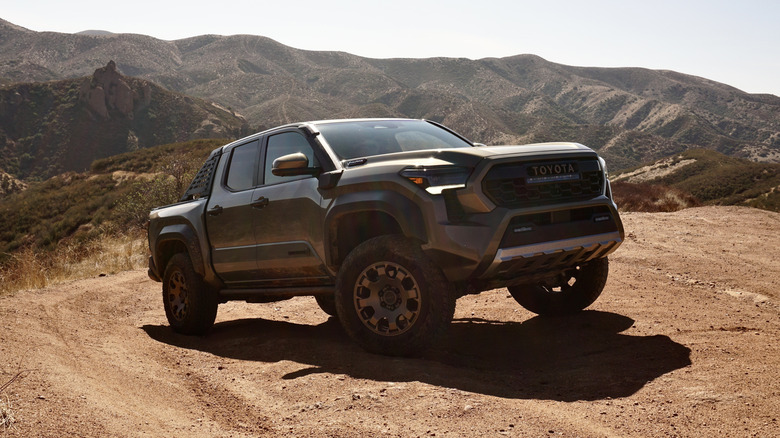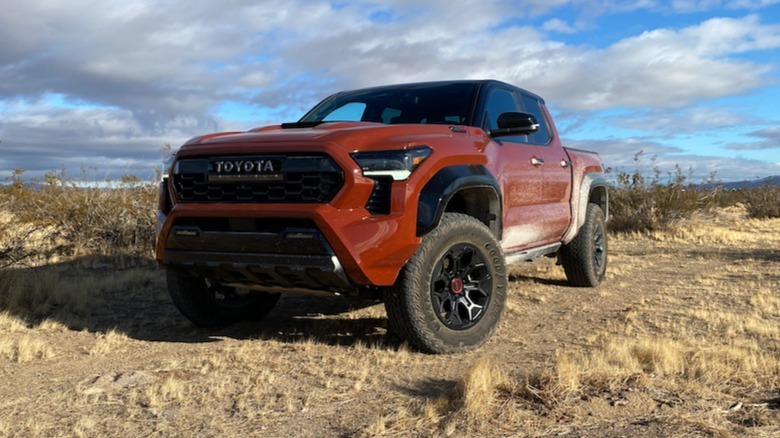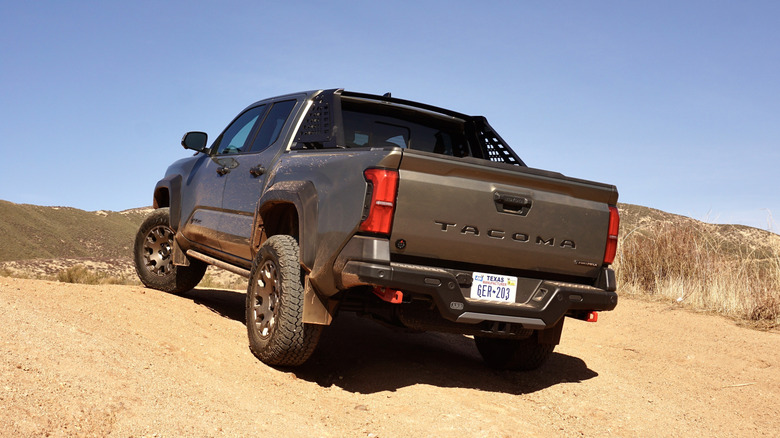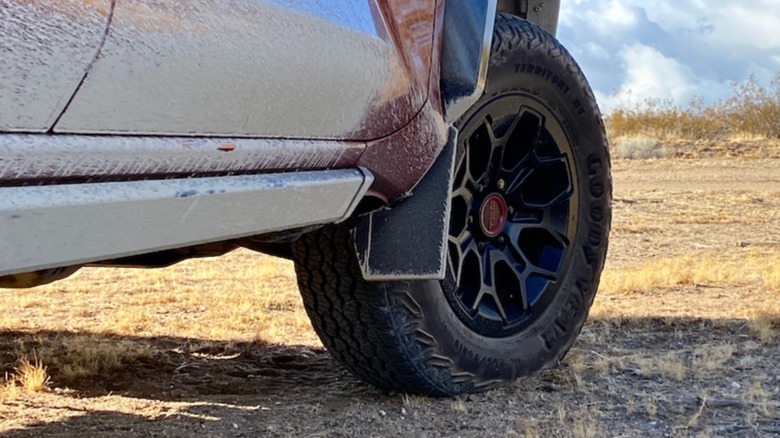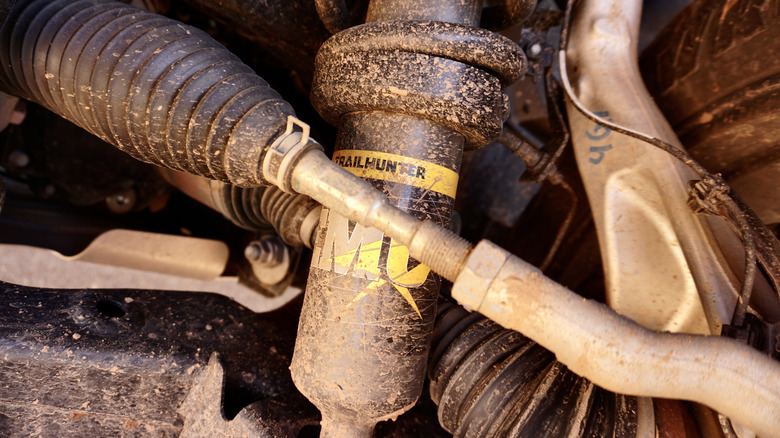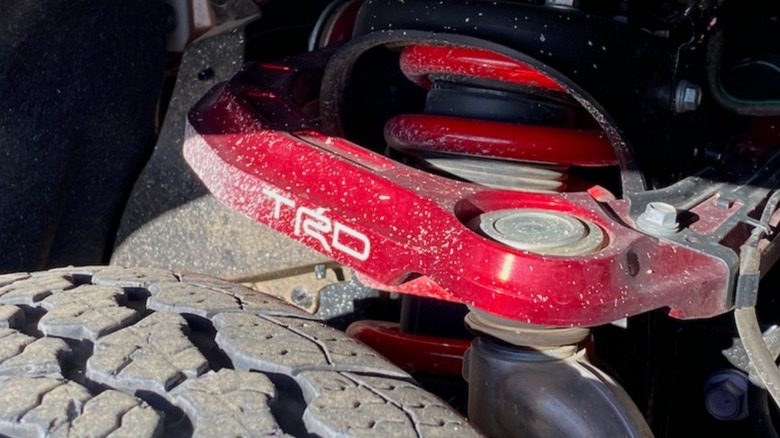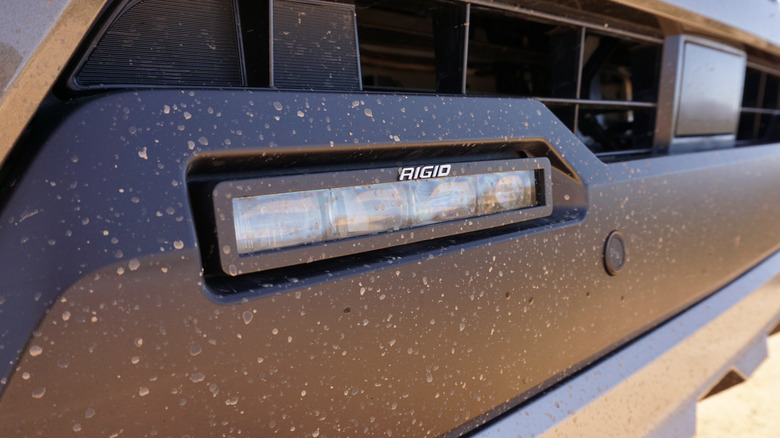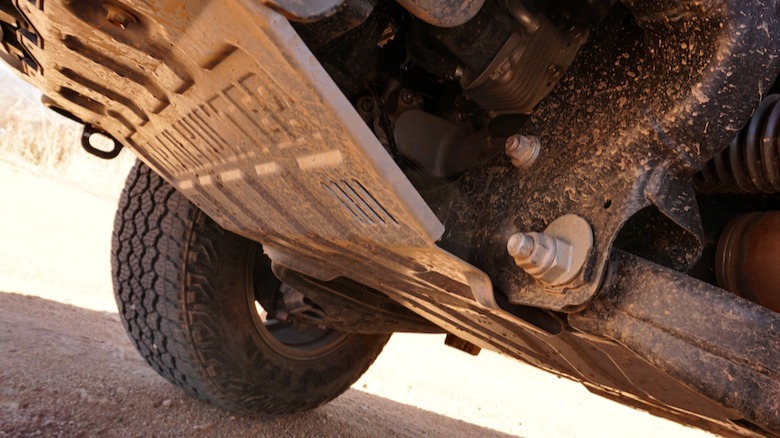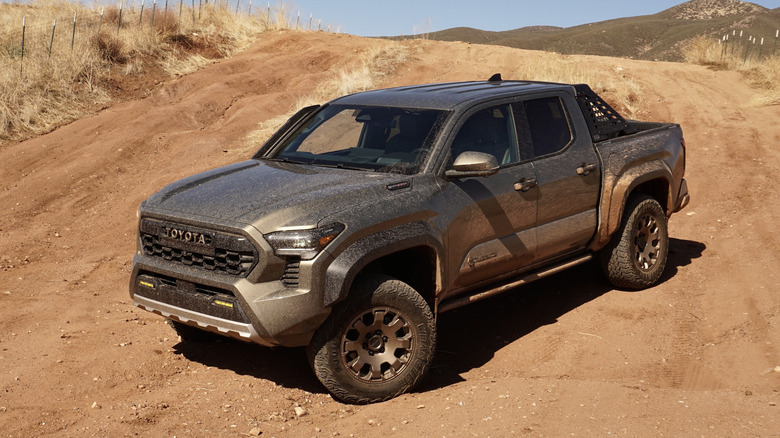Toyota Tacoma Trailhunter Vs. TRD Pro: What's The Difference?
Without a doubt, the Toyota Tacoma is one of the best off-road trucks you can buy today, especially when you go for versions like the Trailhunter or the TRD Pro. Amongst midsize trucks the standard Tacoma offers impressive capability both on and off road. In certain trims, it's one of the least-expensive trucks you can buy today. It's available with two different powertrains (i-Force and i-Force MAX) and with multiple cab and bed configurations, so it's versatile right out of the box. All the various trim levels offered on the Tacoma are part of its appeal to the general public, but at the top of its range, it offers serious off-road prowess. Slow-speed rock-crawling capability, high-speed desert traversing, and just about everything in between is possible in one Taco trim level or another.
Pushing the boundaries of capability, two of the most expensive and most lavishly-equipped versions of the Tacoma are the Trailhunter and the TRD Pro. The TRD Pro is an old stalwart in the Tacoma lineup, known for its impressive equipment levels and capability in previous Tacoma generations, but the Trailhunter is all-new — seen only in the latest-generation Tacoma. So what's the difference between these two versions of the truck? And which one should you spend your money on?
Starting off with the price gap
Certain trims of the Tacoma are pretty inexpensive. A non-hybrid Tacoma SR with steel wheels, the smaller 8-inch touchscreen, and some basic amenities checks in at $33,085 (including a $1,495 destination fee). The Trailhunter and TRD Pro trim levels, however, are nearly double that price. A 2025 Tacoma Trailhunter with the standard bed length is a whopping $64,230. Add the six-foot bed to the equation and the price goes up to $64,730. Not to be outdone, the Tacoma TRD Pro adds another $500 to the price, checking in at $65,230 (it's only available with the standard 5-foot bed). A $1,000 difference between the Trailhunter (with the 5-foot bed) and the TRD Pro might not seem like much, but when we go over the equipment differences in the following sections, you'll see why it's worth considering use cases for each truck before immediately upgrading to the TRD Pro.
With off-roading, accessorizing comes with the territory. Aftermarket mods are available for both trucks but Toyota offers lots of gear directly from the dealership. Both trucks are available with all sorts of dealer-installed accessories including roof racks, tents, off-road recovery kits, upgraded air filters, bed extenders, special badges, spray-on bedliners, and tonneau covers. Be judicious with your selections of options though – just a few key selections and the price of your Tacoma can balloon to over $70,000.
Unique suspension for each trim
Both the Trailhunter and TRD Pro get special suspension components. Four-wheel drive, is of course, standard on both models, along with The Trailhunter gets 2.5-inch Old Man Emu shocks. And if you're wondering what Old Man Emu is, you're probably not alone. OME is an Australian off-road brand that was acquired by ARB in the late 1980s. Long time off-road enthusiasts will recognize the ARB brand for their off-road accessories and the OME shocks are a part of their lineup. Both the TRD Pro and the Trailhunter are covered in ARB gear.
According to Toyota, the OME shocks are designed with off-road control and load-carrying ability in mind. Essentially, they're meant for overlanding setups that carry a lot of gear on a regular basis. The TRD Pro is a bit of a different focus. The TRD Pro gets Fox three-way adjustable internal bypass shocks with remote reservoirs. Where the OME shocks are designed with slow-speed travel and overlanding in mind, these Fox shocks are focused on high-speed performance. If you're choosing between the Trailhunter and the TRD Pro, this difference might be one of the biggest deciding factors between the two trims. Don't plan on bombing across the desert at full tilt? Saving a bit of money and going with the Trailhunter might be the right decision for you.
IsoDynamic seats look cool but practicality takes a hit
The Trailhunter has some pretty impressive front seats. They're well-bolstered and supportive, on top of being heated and ventilated for extra comfort. The TRD Pro gets seats that are a massive upgrade though: IsoDynamic Performance seats. Also heated and ventilated, these performance seats have shock absorbers built in to reduce body movement and stabilize the driver over rough terrain. Remember, those Fox shocks that the TRD Pro gets, and their high-speed capabilities? The IsoDynamic seats are designed for those same kinds of scenarios.
Blasting across the desert, bouncing over bumps, ruts, and whoops, the seats are intended to improve driver focus and comfort. The seats are an incredible innovation for a very specific set of users. Unfortunately, they also take up lots of room. In the back seat of the Tacoma, there's limited legroom even on the base models — just 33.7 inches of legroom on double cab Tacomas. For comparison, the smaller Ford Maverick has 35.9 inches of rear legroom. Toyota doesn't list specific numbers for rear seat legroom with the upgraded IsoDynamic seats, but it would be a very tight squeeze if you tried to fit adults back there. The IsoDynamic seats are only available on the TRD Pro trim level for now, so unless Toyota decides to make them a stand-alone option on other versions of the truck, you'll be paying top dollar for them.
Small equipment differences between the trucks
Setting aside big differences like the IsoDynamic seats, there's a lot that both of these versions of the Tacoma share. Both trucks come with Toyota's Stabilizer Disconnect and 33-inch Goodyear Territory R/T tires wrapped around 18-inch alloy wheels. Both trucks also get in-bed LED lighting and LED headlights. They both have underbody skid plates to protect the truck from off-road damage, and they both have fog lights, light bars, and unique exhausts compared to the rest of the Tacoma lineup. There are lots of little differences, though, if you pay close attention to the details.
The skid plates, for example, are different between the two trucks. The TRD Pro gets aluminum skid plates that protect the transfer case and fuel tank, while the Trailhunter gets steel skid plates in those same locations as well as an additional skid plate to protect the rear differential. The TRD Pro gets single-color Rigid fog lights. The Trailhunter gets a unique version of the Rigid fog lights that can switch between white and amber. The Trailhunter can also be had with the longer 6-foot bed, an option you can't get with the TRD Pro — another advantage if you plan on carrying a lot of gear or a heavy-duty camper shell. The Trailhunter has a high-clearance exhaust tip, while the TRD Pro has two prominent exhaust tips located near the rear tire.
Power is ever-so-slightly different, but you won't notice
Under the hood, the Trailhunter and the TRD Pro both use Toyota's i-Force MAX engine. It's a turbocharged 2.4-liter four-cylinder engine paired with a hybrid system for a combined output of 326 hp and 465 lb-ft of torque — at least with the TRD Pro. In the Trailhunter, output is slightly lower at 323 hp.They're dead even when it comes to fuel economy, with EPA estimates of 23 mpg combined (22 city/24 highway). Bury your foot in the throttle in either truck and acceleration is stout, but not class leading. When Car and Driver tested the Tacoma TRD Pro, zero to 60 mph took 7.7 seconds — way behind the Ford Ranger Raptor, which did the sprint in 5.3 seconds.
A difference you will notice when driving these two trucks, however, is the sound coming from the Trailhunter's snorkel (which they call a high-mount air intake). The Trailhunter's high-mounted intake is there to help with fording bodies of water. Take the Trailhunter across a shallow river or deep creek, and the high-mount intake is able to provide the engine air without hydrolocking the engine. Some fun side effects of the snorkel's placement, however, are the fun turbo fluttering noises that are audible any time you accelerate with a bit of gusto. It adds character to the Tacoma's driving experience, especially with the windows down, but some drivers may find it tough for everyday driving.
